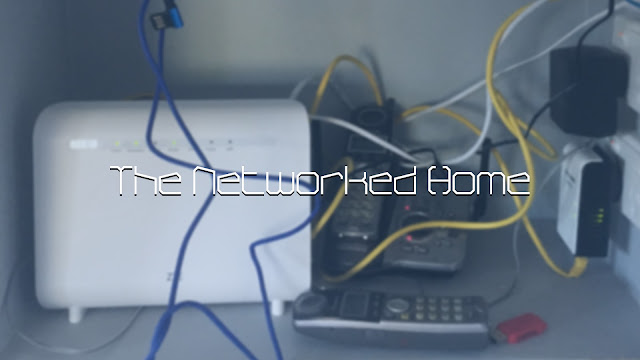(The above image was taken by myself of the router in my family home)
This was written for the University subject, BCM241.
Looking around a modern home, it's not at all surprising or incredibly interesting to note just how many gadgets are lying about the place. It's all too common that most places you will go to in your life will be crowded with technology in some way, shape or form. Whether or not that's strictly a good or bad thing is not the point of this article, however. Besides, I think the issue is far more grey than merely a straight black and white, "with us or against us" issue. No, instead, this post is going to be discussing the minutiae of technology in my own home.In the image above, you can see the nook in the wall where my family's router and phone is situated, tangled in a mess of precariously hanging, tenuously connected cables and wires. Among the disarray is a small red USB thumb drive that somebody has carelessly left behind. Its contents remain a mystery to me. But in case, for some unlikely reason, there's some sort of sensitive material on it, I won't plug it in and take a look at its contents as tempting as that is.
Despite the complexity of objects in this alcove, it's only a small part of the home. Just across from it is a TV suspended in mid-air by a metallic folding structure bolted to the wall. Of course, being a modern television set, it's connected to the Internet and can access different services and websites. Underneath is a series of cabinets filled with miscellaneous objects like remotes, game controllers and old consoles like the PlayStation, yellowing from age.
Further away and down the hall is the second television set. The floor is wood with a carpet in the lounge area, and it's quieter compared to the previous room too. Perfect for plugging in the PlayStation 4 and enjoying a session of Bloodborne, a particularly difficult game with wireless capabilities, allowing users to place 'notes' in the game world to tell players of upcoming dangers, bosses and traps...or trick them into doing something foolish that leads to their deaths in-game. It also allows you to 'invade' other players' games to act as a help or hindrance. Many games, both on PC and console, have similar (or dissimilar) usage of multiplayer, allowing players to connect to each other from around the world as well as facilitating the cultivation of an online persona.
As a result of this, video games, as a form of media or literature, is one example of "how the Internet, far from being experienced as a cyberspace apart from everyday experience, is strictly intertwined with the everyday life of participants..." (Caliandro, 2017). It's only one example of where the simple act of play is experienced with others in a virtual world instead of on a real-world football pitch, basketball court or tabletop. Indeed, if you want to play those types of games, there are usually direct equivalents with titles like Tabletop Simulator, which allows you to play different tabletop games with several friends or strangers.
You can also use an application like PS4 Remote Play as part of the networked home by plugging in your PS4 and using a laptop's or desktop's monitor as a screen for the console by streaming it over Wi-Fi. It'd be useful for many, myself included, as they'd be able to stay in their room and someone else in the house could use the TV for their own entertainment purposes. However, with the current state of the NBN in Australia, it's not something that usually works, if at all (unless everyone is asleep or out of the house).
And all this is only from a cursory glance. I can go into much further detail, but for the sake of brevity and keeping this article concise, I will end it there. But that should give you a clear idea of just how deeply connected with technology the modern home is. It's not a new concept, but if you try this same observation for yourself in your own home and 'pull back the curtain' as it were, you might be surprised by what you find.
--Written/Edited on 5th September 2019
References:
Caliandro, A 2017, 'Digital Methods for Ethnography: Analytical Concepts for Ethnographers Exploring Social Media Environments', Journal of Contemporary Ethnography, vol. 47, no. 5, pp. 551-578.

Comments
Post a Comment